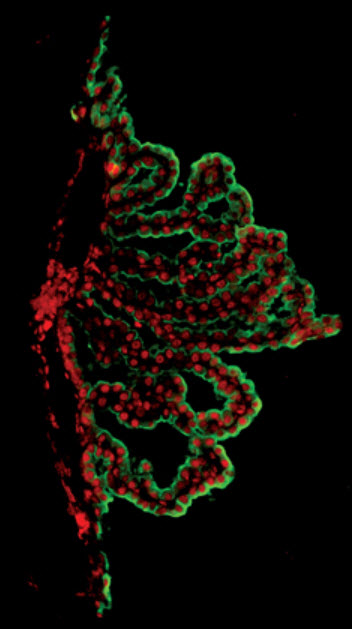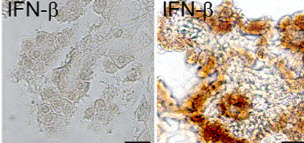The signature of aging in the brain
October 7, 2014

Immunofluorescence microscope image of the choroid plexus. Epithelial cells are in green and chemokine proteins (CXCL10) are in red (credit: Weizmann Institute of Science)
Weizmann Institute of Science researchers have found evidence of a unique “signature” that may be the “missing link” between cognitive decline and aging and that may in the future lead to treatments that can slow or reverse cognitive decline in older people, according to Prof. Michal Schwartz of the Department of Neurobiology and Ido Amit of the Department of Immunology.
Until a decade ago, scientific dogma held that the blood-brain barrier prevents blood-borne immune cells from attacking and destroying brain tissue.
Yet in a long series of studies, Schwartz showed that the immune system actually plays an important role both in healing the brain after injury and in maintaining the brain’s normal functioning.
Immunological age
Her team have found that this brain-immune system interaction occurs across a barrier that is actually a unique interface within the brain’s territory: the choroid plexus. This structure is found in each of the brain’s four ventricles, and it separates the brain’s blood from the cerebrospinal fluid.
“The choroid plexus acts as a ‘remote control’ for the immune system to affect brain activity,” Schwartz explains. “Biochemical ‘danger’ signals released from the brain are sensed through this interface; in turn, blood-borne immune cells assist by communicating with the choroid plexus. This cross-talk is important for preserving cognitive abilities and promoting the generation of new brain cells.”
This finding led Schwartz and her group to suggest that cognitive decline over the years may be connected not only to one’s “chronological age,” but also to one’s “immunological age,” that is, changes in immune function over time might contribute to changes in brain function that are not necessarily in step with the count of one’s years.
To test this theory, Schwartz and research students Kuti Baruch and Aleksandra Deczkowska teamed up with Amit and his research group. The researchers used next-generation sequencing technology to map changes in gene expression in 11 different organs, including the choroid plexus, in both young and aged mice, to identify and compare pathways involved in the aging process.
Signature of aging found

Representative micrographs of immunohistochemical staining for IFN-β in young (left) and aged (right) human postmortem choroid plexus tissues (credit: Kuti
Baruch et al./Science)
In the research, they identified a unique “signature of aging” that exists solely in the choroid plexus. They discovered that one of the main elements of this signature was interferon beta, a protein that the body normally produces to fight viral infection.
Turns out this protein also appears to have a negative effect on the brain. When the researchers injected an antibody that blocks interferon beta activity into the cerebrospinal fluid of the older mice, their cognitive abilities were restored, as was their ability to form new brain cells.
The scientists were also able to identify this unique signature in elderly human brains.
The scientists hope that this finding may, in the future, help prevent or reverse cognitive decline in old age by finding ways to rejuvenate the immunological age of the brain.
Ido Amit’s research is supported by the M.D. Moross Institute for Cancer Research; the J&R Center for Scientific Research; the Jeanne and Joseph Nissim Foundation for Life Sciences Research; the Abramson Family Center for Young Scientists; the Wolfson Family Charitable Trust; the Abisch Frenkel Foundation for the Promotion of Life Sciences; the Leona M. and Harry B. Helmsley Charitable Trust; Sam Revusky, Canada; the Florence Blau, Morris Blau and Rose Peterson Fund; the estate of Ernst and Anni Deutsch; the estate of Irwin Mandel; and the estate of David Levinson. Dr. Amit is the incumbent of the Alan and Laraine Fischer Career Development Chair.
Prof. Michal Schwartz’s research is supported by the Jeanne and Joseph Nissim Foundation for Life Sciences Research; the Adelis Foundation; the European Research Council; Nathan and Dora Oks, France; and Hilda Namm, Larkspur, CA. Prof. Schwartz is the incumbent of the Maurice and Ilse Katz Professorial Chair of Neuroimmunology.
Abstract of Aging-induced type I interferon response at the choroid plexus negatively affects brain function
Aging-associated cognitive decline is affected by factors produced inside and outside the brain. By using multiorgan genome-wide analysis of aged mice, we found that the choroid plexus, an interface between the brain and the circulation, shows a type I interferon (IFN-I)–dependent gene expression profile that was also found in aged human brains. In aged mice, this response was induced by brain-derived signals, present in the cerebrospinal fluid. Blocking IFN-I signaling within the aged brain partially restored cognitive function and hippocampal neurogenesis and reestablished IFN-II–dependent choroid plexus activity, which is lost in aging. Our data identify a chronic aging-induced IFN-I signature, often associated with antiviral response, at the brain’s choroid plexus and demonstrate its negative influence on brain function, thereby suggesting a target for ameliorating cognitive decline in aging.
